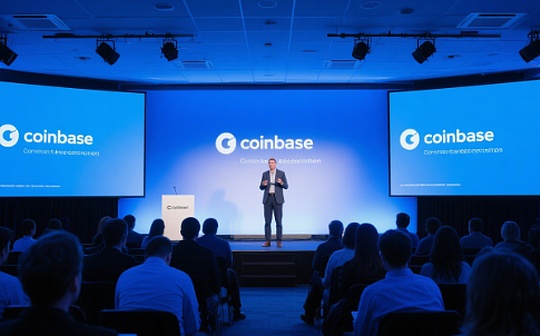What is the impact of the continued riots in Los Angeles on the U.S. economy and crypto market

Reprinted from jinse
06/11/2025·5DDeng Tong, Golden Finance
The United States has a tradition of summer protests, but this year seems to be coming particularly early.
(Golden Finance Note: The Civil Rights Movement from 1954 to 1968, the Anti- Vietnam War protests in the late 1960s, and the Tea Party Movement in 2009 all occurred in the summer. Some analysts believe that this is related to the hot weather and the ignition of emotions and holidays.)
On June 6, 2025, the U.S. Immigration and Customs Enforcement (ICE) arrested more than 40 illegal immigrants in Los Angeles. Trump's move can be regarded as the beginning of this riot in Los Angeles. Trump sent 2,000 National Guard soldiers to the city, sparking anger among Democrats. Subsequently, the situation continued to ferment, and Trump ordered the dispatch of 2,000 Army soldiers and 700 Marines to the city. At present, the mayor of Los Angeles has declared a state of emergency in Los Angeles and a curfew is imposed in downtown Los Angeles.
Why did the riots break out in Los Angeles? Have immigrants really taken the job of Americans? What tough measures did Trump use? What impact did the riots have on the US economy? Will it affect the cryptocurrency market?
1. Review of the riots in Los Angeles
1. Why did the riots break out in Los Angeles?
The riot actually originated from the "largest deportation" carried out by Trump in the history of the United States, and more than one-third of the population in Los Angeles was born outside the United States, so it has always been the key target of this operation. For example, the West Lake and Paramount Districts in Los Angeles - more than 82% of the population is Hispanic.
In early May, the Immigration and Customs Enforcement Agency (ICE) announced the arrest of 239 undocumented immigrants in a week-long operation in the Los Angeles area, but the overall number of arrests and deportations lags behind Trump’s expectations. The following month, the White House raised its target of ICE officials to arrest at least 3,000 people per day. Authorities have gradually expanded their search scope and included workplaces such as restaurants and retail stores.
2. What happened during the riot?
The vehicle was burned on Sunday and police accused protesters of using a burning device against Mounted Police Patrol. Meanwhile, policemen in riot gear uniformed the crowd using flash bombs and pepper spray. The riots temporarily paralyzed Highway 101 and reported robbery.
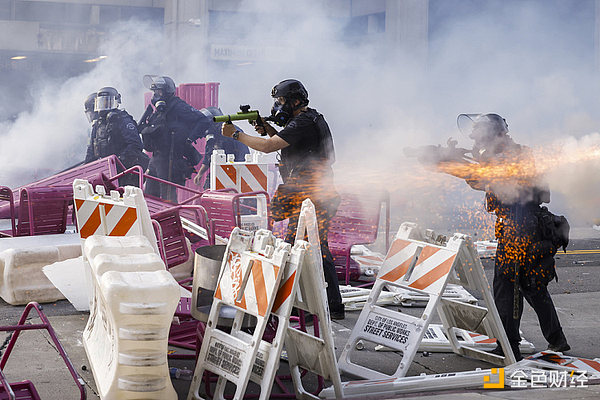
The federal building in the city center has been in the spotlight for allegedly detaining ICE prisoners. ICE accused "more than 1,000 thugs" of siege and attacking the building on Saturday.
A Home Depot store in Paramount, about 20 miles (32 kilometers) south of downtown Los Angeles, became another important protest site. Protesters gathered on Saturday were attacked by tear gas and flash bombs, and the armed National Guard was stationed at a nearby commercial park on Sunday.
The Los Angeles Police Department (LAPD) said 29 people were arrested on Saturday. Another 27 people were arrested on Sunday.
San Francisco police said Sunday's riots resulted in about 60 arrests and three police officers injured.
The protests continued on Monday, with police firing stun grenades to try to disperse the crowd. Later that day, the riots gradually subsided, with the violence and the number of street workers decreasing from the weekend.
3. Respond to multiple parties
The mayor of Los Angeles has declared a state of emergency in Los Angeles, and a curfew is imposed in downtown Los Angeles.
Trump said he would use all resources to calm the violence in Los Angeles. Trump delivered a speech at Fort Bragg, calling the riots in Los Angeles a "full attack on peace, public order and national sovereignty by a group of mobs waving foreign flags" with the aim of continuing a "foreign invasion" against the United States. Trump said those who burn the American flag should be sentenced to one year in prison. Trump said that if he did not deploy the guards, Los Angeles would be "burned". The guards deployed to Los Angeles are protecting U.S. Immigration and Customs Enforcement agents and are blocking the invasion. Trump said that the governor of California and the mayor of Los Angeles are "incompetent" and that the Trump administration will "liberate Los Angeles."
On the 10th local time, the US Northern Command said that 700 Marines had arrived in the Los Angeles area. The US Northern Command issued a statement on the 9th that about 700 Marines have completed the mobilization and will "seamlessly connect" with the National Guard deployed in the Los Angeles area of California to protect federal agencies and personnel in the Los Angeles area. CNN reported that sending the entire Marine Battalion to Los Angeles marks a significant escalation in the Trump administration's military display of force against protesters.
The latest poll results released by the polling agency Yuguan Survey on the 10th showed that nearly half of the American people do not support the Trump administration 's deployment of Marine Corps and National Guards to the Los Angeles area of California. In a poll completed on the 10th, 47% of respondents opposed sending Marines to the Los Angeles area to support federal agencies' enforcement actions against illegal immigration, and 34% expressed their consent. The proportion of opposing and supporting the deployment of the National Guard to the Los Angeles area was 45% and 38% respectively.
Some analysts believe that the speed of Trump 's reaction shows that this is a struggle his administration is ready and even eager to engage in.
The White House believes that law and order and active immigration enforcement will win Trump. His actions will inspire his core supporters and may affect political independents who care about public safety.
Democrats say the administration’s use of masked and military-equipped immigration officials to arrest civilians in restaurants and shops is inflammatory, and the president’s rush to deploy well-trained soldiers is unreasonable.
"The president does this without being asked to break the tradition of generations and only exacerbates the situation and makes things worse," said Sen. Cory Booker, New Jersey . "Many peaceful protests have occurred because the U.S. president arrested those who attended immigration hearings and worked to comply with the law, thus creating chaos and confusion."
2. Have immigrants really taken the job of Americans?
The root cause of this riot is Trump 's increasingly tightened immigration policies.
On January 20, 2025, the Trump administration issued a number of immigration- related executive orders focusing on border security, the withdrawal of humanitarian programs, the escalation of visa applicants, and attempts to terminate birth citizenship. In addition, several executive orders issued by Biden have been repealed.
Is immigrants really unfavorable to the development of the US economy?
According to demographers, there are currently about 8.3 million illegal immigrants in the United States, accounting for about 5% of the total labor force. Economists warn that evicting all workers in these key industries could lead to higher food prices and housing construction costs. The existing staff shortages in nursing homes and home health facilities will increase, leading to reduced services and higher costs.
According to a research report in the U.S. Congress, in fact, current economic analysis is hardly able to prove that immigrants seize American jobs, and the economic impact of immigrants is mostly positive for local residents and the overall economy.
Figure 1 shows that in recent decades, foreign birth population has grown rapidly, from less than 5% of the U.S. population in 1970 to 13% in 2013. Although immigrants today account for a larger proportion of the U.S. population than at any time since World War II, the current proportion of foreign births is roughly the same as in the late 19th and early 20th centuries, when about 15% of American residents were born abroad.
Figure 1: The proportion of foreign-born population among the U.S. population from 1850 to 2013
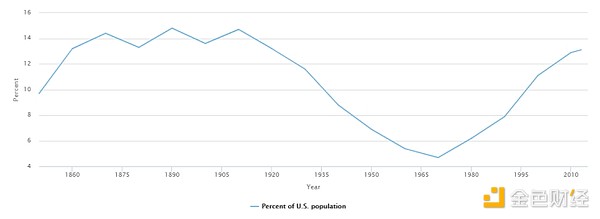
Has the surge in immigration caused a slowdown in wage growth for local workers since 1970? Academic research does not provide much support for this claim. Evidence shows that when immigrants increase the labor supply, businesses increase investment to offset the decline in per capita capital, thus preventing a long-term decline in average wages. In addition, immigration is often not a perfect alternative to native workers in the U.S. labor market. This means they won’t compete for the same jobs and the downward pressure on local workers’ wages is minimal. This may explain why competition from new immigrants mainly affects early immigrants, whose wages have dropped significantly due to the surge in immigration. In contrast, the study found that over the past few decades, immigrants have actually increased the average wages of native workers.
Immigration is a pioneer in innovation and creativity in the United States, with an extremely high percentage of patent applications, tech graduates, and senior positions in top venture capital firms. According to a 2012 report by the National Science Commission, in 2009, foreign students received 27% of master's degrees in science and engineering. In 2011, 76% of the top ten universities in the U.S. patent production had at least one foreign-born author. More than three-quarters of the growth of the U.S. economy over the past 150 years can be attributed to improved education and research-driven innovation. In addition, the presence of immigrants often creates opportunities for less skilled native workers to engage in their work more professionally, thereby increasing their productivity.
Immigration also often improves the government's financial situation, as many immigrants pay more taxes throughout their lifetime than the government services they consume. However, in states with low-educational immigrant concentrations, native residents may face a greater tax burden, as these immigrants pay less taxes and are more likely to send their children to public schools.
Most empirical studies show that immigration has long-term benefits for native people’s employment and wages, although some studies show that these benefits come at the expense of short-term losses caused by lowering wages and increasing unemployment. Standard economic theory shows that while the increased labor supply brought by immigration may initially lower wages, over time, businesses increase investments to restore per capita capital, thus restoring wages. Steady growth in the capital-labor ratio prevents workers’ average productivity from falling, thus preventing their average wage from falling over a long period of time.
Figure 2 shows the capital-labor ratio trends before 1980 and infers the next few decades – a period of accelerated immigration in the United States. Consistent with the theory, after 1980, the actual capital-labor ratio did not deviate significantly or permanently from this trend.
Figure 2: Logarithmic capital-labor ratio in the United States from 1948 to 2013
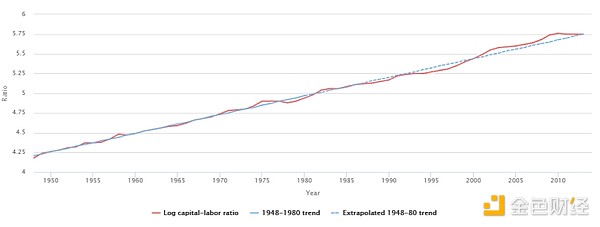
Table 1 shows that immigration mainly increases the supply of lowest-skilled workers and highest-skilled workers.
Table 1. Distribution of education level of population aged 25 and above in 2012

Table 2 presents the results of two academic analyses on the impact of immigration on wages over the past few decades. These two studies consider the investment response of firms and the incomplete substitution between immigrant and native workers. They found that immigration had a small but positive impact on the average workforce assets of local workers, about half a percentage point. One of the studies showed that wages for people without high school or college degrees fell slightly, while another found that wages only saw positive growth. In sharp contrast, both studies found that early immigrant wages fell by an average of 4% to 7%, mainly concentrated in the highest and lowest education populations.
Table 2. Estimates of Immigration’s Impact on Long-term Wages
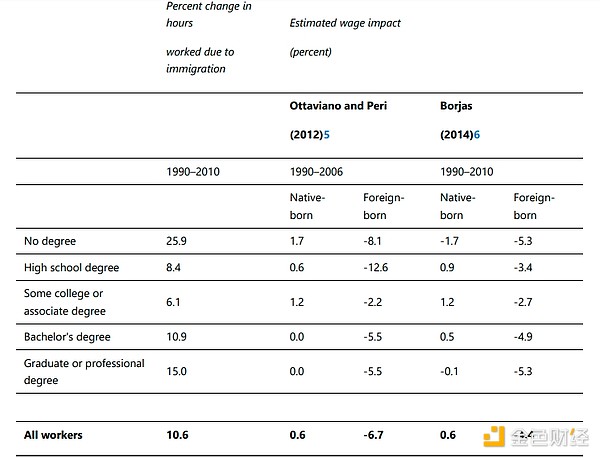
In summary, immigrants are actually beneficial to the development of American society. Trump's ever-tightening immigration policies may have a counterproductive negative impact on the United States.
3. Trump's immigration policy is affecting the US economy together with
tariff policy
The Brookings Institutional research points out:
In the short term, a sharp decline in net immigration will curb real GDP growth. This is because this reduction means a smaller labour force, resulting in a decrease in the number of people producing goods and services. Specifically, if the net immigration number drops from a significantly positive value in 2024 to -650,000 in 2025, the decrease in immigration output will lead to a 0.2 percentage point reduction in GDP growth next year. In line with a slowdown in labor force growth, monthly employment growth is expected to be much lower in 2025 than in 2024. Specifically, the reversal from positive net immigration to negative net immigration will result in a decrease of nearly 100,000 monthly employment growth.
In addition, the reduction in immigration has led to a decrease in consumer spending, which will lead to companies cutting investment and recruitment, further reducing GDP growth by 0.1 percentage point . Finally, even if the mass deportation implied by propaganda is not achieved, the implementation of radical deportation policies may reduce spending on immigrants who remain in the United States, which will further reduce GDP growth. If the net immigration number in 2025 is smaller, its economic impact will be more negative.
Perhaps a total of 3 million people will be deported in four years, far below the deportation target proposed in Trump's campaign rhetoric. Higher eviction rates will have more adverse macroeconomic consequences and will disrupt labor markets, supply chains and civil society.
In fact, it is not just immigration policies that are burying the US economic growth, but Trump’s swinging tariff policies are also casting a shadow on the US economy.
According to the World Bank , as the impact of Trump's tariff policy gradually emerges, the global economy will experience the slowest decade since the 1960s - the global economic growth rate in 2025 was only 2.3%, 0.4 percentage points lower than the January forecast, while the forecast growth rate in 2027 was 2.6%. As the tariff stick swayed, affecting investor confidence and private consumption, the World Bank also lowered its growth forecast for the U.S. in 2025 and 2026.
Musk pointed out: Trump's tariff policy will lead to a US economic recession in the second half of this year; the OECD warned that Trump's tariff policy would damage US economic growth; Bank of America analysts pointed out that the negative impact of tariff policy on the US economy and the US dollar is more significant; hedge fund tycoon Steve Cohen believes that the probability of US economic recession is about 45%...
Deutsche Bank even warned that the negative impact of immigration policy on the US economy is even greater than that of Trump's tariff stick.
4. How will the crypto market go in the future?
The riots in Los Angeles are still ongoing, and for the moment we can see it as a continuation of a short-term emergency or as an appetizer for larger riots in the future.
However, according to foreign media reports, protesters in Los Angeles have organized the "No Kings" event, which will be held on June 14 at the same time as a military parade commemorating the 250th anniversary of the founding of the US Army. Therefore, it is not ruled out that the current riots in Los Angeles will continue to escalate in the next few days.
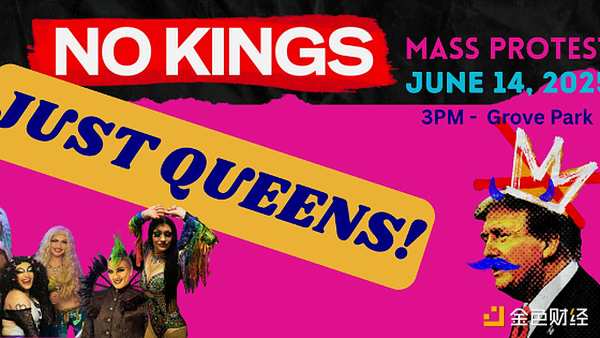
In the short term, market panic may lead to temporary selling pressure. As U.S. economic risks intensify, investors need to reassess the holdings of risky assets such as stocks and cryptocurrencies. If American society is instability and intensifies and further affects economic growth, investors will tend toward assets with more stable value, and cryptocurrencies may face the risk of intensifying price volatility.
But in the long run, the crypto market trend is still improving due to factors such as the continuous improvement of crypto regulatory policies, the manifestation of the "digital gold" attributes given by "de-dollarization" to BTC, and the increase in national and institutional allocation. And it may further increase the demand for decentralized assets among ordinary people.
Source: Golden Finance, US Congress, BBC, RFI, Brookings Institution, Seacoastonline, etc.


 chaincatcher
chaincatcher

